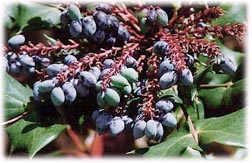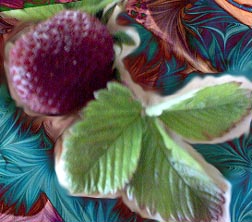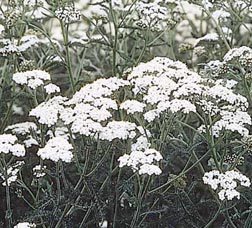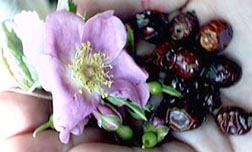
A Country Rag |

by H.m.Jobst
 Wildcrafting is the natural selection of medicine from an area where it is plentiful and unpolluted. Wildharvesting is done with consideration of the moon's position, to harvest above ground (flowers, leaves) when waxing (before the full moon), or below ground (roots) when waning (after the full moon). Before you harvest these wonderful natural cures, please consider how much you really need. It is an unspoken rule to leave more for others, and always to leave enough for seed. You will be keeping the ancient traditions. Another ancient tradition of Native Americans is to bring an offering and say a prayer to the Great Spirit and the plant from which you harvest. Know what you are looking for by researching and learning all the specific elements of the herb you will harvest. Look at the leaves, the flowers, the stalk, and the root. There are specific medicinal properties for each herb, which can help you define your particular needs. Are you prone to stomach aches? You may need a carminative, an herb that expels wind from the bowels, or a stomachic, an herb that strengthens the stomach and relieves indigestion. Do you have a sore throat? You may need an expectorant, such as choke cherry bark. Need a vitamin C boost? Look for a wild rose bush in fall, and collect rosehips.
Wildcrafting is the natural selection of medicine from an area where it is plentiful and unpolluted. Wildharvesting is done with consideration of the moon's position, to harvest above ground (flowers, leaves) when waxing (before the full moon), or below ground (roots) when waning (after the full moon). Before you harvest these wonderful natural cures, please consider how much you really need. It is an unspoken rule to leave more for others, and always to leave enough for seed. You will be keeping the ancient traditions. Another ancient tradition of Native Americans is to bring an offering and say a prayer to the Great Spirit and the plant from which you harvest. Know what you are looking for by researching and learning all the specific elements of the herb you will harvest. Look at the leaves, the flowers, the stalk, and the root. There are specific medicinal properties for each herb, which can help you define your particular needs. Are you prone to stomach aches? You may need a carminative, an herb that expels wind from the bowels, or a stomachic, an herb that strengthens the stomach and relieves indigestion. Do you have a sore throat? You may need an expectorant, such as choke cherry bark. Need a vitamin C boost? Look for a wild rose bush in fall, and collect rosehips. If you know what you are looking for, you may find a simple natural remedy to your ailment. By no means is this intended to replace the professional advice of a trained physician. My experience comes from experimenting in times of necessity. My entire family has willingly accepted to be my patients and share the power of natural healing.
|
 Oregon Grape Root and Berries, Berberis Aquifolium species, is a profuse ground ivy bush, with waxy dark green leaves, produces yellow flowers and fruits purple berries. Oregon Grape is an excellent tonic, known to detoxify the body of built up toxins, can be found across Oregon state (it's the state flower) and the nation. In early spring, we dig roots, dry them by hanging, and boil for tea as needed. Later in spring, we use the yellow waxy berry shape flowers for dyeing cloth. In the summer, we can our Oregon grape jelly made with natural pectin, like Pomona's, and add honey. Similar properties are found in Goldenseal, which is rapidly becoming over-harvested. Oregon Grape is a better choice because of its plentitude, its multiple uses, and its hardiness to most climates. I believe we should consider the use of medicine and foods found in our native land.
|
Nettles have been used by many dreads as a hair rinse. Simply, preboil water; add chamomile, nettles, licorice root, yarrow, and fennel. Add henna for color, if desired. Strain and rinse hair. Nettles grow in forests and marsh areas. Use gloves when wildcrafting, by pressing the fine hairs downward against the stem and pinching. Hang to dry out of sunlight. The stalk of nettles are stripped and dried to make a fiber. The stalk of Nettles are stripped, dried, and weaved to make the fiber Raime.
|
 "This article has been presented for your life enhancement by H.m.Jobst. References:
Kloss, Jethro Back to Eden Lifeline Books, 1972 Riverside, California;
Wigginton, Eliot Foxfire 2, Anchor Books, Doubleday 1973,
Hydrastis (goldenseal) and Berberis (Oregon grape root);
Grieve, M. Mrs. A modern herbal;
Culpepper's Compleat Herbal;
Wild Harvest; Edible Plants of the Pacific Northwest, Terry Domico, 1979 Hancock House.
Questions about these herbs? Find some scientific info here: National Center for Complementary and Alternative Medicine.
"This article has been presented for your life enhancement by H.m.Jobst. References:
Kloss, Jethro Back to Eden Lifeline Books, 1972 Riverside, California;
Wigginton, Eliot Foxfire 2, Anchor Books, Doubleday 1973,
Hydrastis (goldenseal) and Berberis (Oregon grape root);
Grieve, M. Mrs. A modern herbal;
Culpepper's Compleat Herbal;
Wild Harvest; Edible Plants of the Pacific Northwest, Terry Domico, 1979 Hancock House.
Questions about these herbs? Find some scientific info here: National Center for Complementary and Alternative Medicine.
|
|
Go to: Word Preserve Appalachian Scenes A Country Rag Index
text and photos ©H.m.Jobst; graphics ©Jeannette Harris, June 2000. All rights reserved. |





 "H.m.Jobst lives with her family in Southern Oregon, where she forages for
wild medicine and foods. She enjoys writing, raising her children,
gathering with enlightened beings at festivals and barter faires, gardening,
hiking, wildcrafting,
singing, and sharing time with family. 'I am commited to raising
consciousness about the importance of wild foods and medicine, and positive
education for children. I consider myself blessed to live in this age of
information, and feel sharing is the key element to harmony.' " -
"H.m.Jobst lives with her family in Southern Oregon, where she forages for
wild medicine and foods. She enjoys writing, raising her children,
gathering with enlightened beings at festivals and barter faires, gardening,
hiking, wildcrafting,
singing, and sharing time with family. 'I am commited to raising
consciousness about the importance of wild foods and medicine, and positive
education for children. I consider myself blessed to live in this age of
information, and feel sharing is the key element to harmony.' " - 